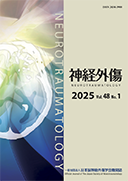Introduction: Adult moyamoya disease is typically managed conservatively when perfusion studies indicate mild hemodynamic disturbance. However, whether traumatic intracranial hemorrhage increases the risk of ischemic stroke in these patients remains poorly understood. Here we presents two cases of adult moyamoya disease who developed ischemic stroke following traumatic intracranial hemorrhage.
Case 1: A 46–year–old woman with bilateral moyamoya disease was initially managed conservatively following a nonaneurysmal subarachnoid hemorrhage. Two years after the diagnosis, she had a head injury in a traffic accident. A head CT scan revealed a small traumatic subarachnoid hemorrhage, predominantly in the left frontal lobe, for which conservative treatment was selected. The day after the injury, asymptomatic multiple ischemic strokes were identified in the left insular gyrus and frontal cortex, despite no significant changes detected on magnetic resonance angiography and perfusion studies. The patient remained asymptomatic and was discharged on day 16 with a modified Rankin Scale (mRS) score of 0.
Case 2: A 79–year–old woman with asymptomatic moyamoya disease was on antiplatelet therapy for stroke prevention. Six years after the diagnosis, she had a head injury due to a fall. An initial head CT revealed a diffuse subarachnoid hemorrhage and right acute subdural hematoma. An emergency craniotomy was performed, and her level of consciousness improved postoperatively. However, seven days after the surgery, she developed ischemic stroke in the left parietal lobe. Despite resumption of antiplatelet therapy, multiple cerebral infarctions progressed, and the patient died fourteen days after the surgery.
Discussion: Many patients with moyamoya disease who are asymptomatic or have mild hemodynamic disturbance are managed conservatively. However, even in the absence of significant hemodynamic disturbance, such patients may exhibit reduced tolerance to microcirculatory disturbances such as dehydration, anemia, and vasospasm following head trauma and trigger ischemic stroke. Our cases suggested even in patients with mild hemodynamic disturbance, we should carefully avoid dehydration, promptly correct anemia, and judiciously administer antiplatelet therapy. Active imaging surveillance may be also crucial to detect early signs of ischemic stroke and guide timely intervention.
View full abstract
